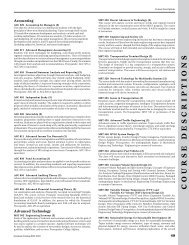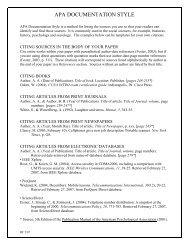Expanding the Public Sphere through Computer ... - ResearchGate
Expanding the Public Sphere through Computer ... - ResearchGate
Expanding the Public Sphere through Computer ... - ResearchGate
You also want an ePaper? Increase the reach of your titles
YUMPU automatically turns print PDFs into web optimized ePapers that Google loves.
CHAPTER 4. ABORTION DISCOURSE IN THE PUBLIC SPHERE 58<br />
4.1 Historic Overview of Abortion Policy in <strong>the</strong> United<br />
States<br />
The abortion issue in American political history can best be understood in three<br />
broad phases:<br />
Pre-Criminalization Phase From <strong>the</strong> earliest days of <strong>the</strong> Republic, <strong>through</strong> <strong>the</strong><br />
1850s, abortion was essentially a “non-issue.” Most states and <strong>the</strong> federal<br />
government were silent on <strong>the</strong> legal issues concerning abortion.<br />
Criminalization Phase Starting in <strong>the</strong> 1850s, and <strong>through</strong> 1973, abortion was<br />
illegal in most states, with some exceptions to save <strong>the</strong> life of <strong>the</strong> mo<strong>the</strong>r.<br />
Constitutional Right Phase Following <strong>the</strong> U.S. Supreme Court’s decision in Roe<br />
v. Wade, <strong>the</strong> right to an abortion during <strong>the</strong> early phases of pregnancy is<br />
considered to be protected by <strong>the</strong> U.S. Constitution.<br />
Standard works on <strong>the</strong> history of abortion in <strong>the</strong> United States (c.f. Means 1970,<br />
Mohr 1978, Luker 1984, Tribe 1990) document that prior to 1850, most states – as<br />
well as <strong>the</strong> federal government – were silent on <strong>the</strong> legality of abortion, and that<br />
little if any public discussion concerning this issue occurred. Within each state,<br />
abortions were governed by common law, which by tradition permitted abortions<br />
until “quickening,” <strong>the</strong> first perception of fetal movement by <strong>the</strong> woman. The earliest<br />
abortion statute, passed in Connecticut in 1821, was designed to protect <strong>the</strong><br />
health of <strong>the</strong> mo<strong>the</strong>r, and applied only to post-quickening abortion. Abortions appear<br />
to have been relatively common during <strong>the</strong> first half of <strong>the</strong> nineteenth century,<br />
even though <strong>the</strong> mortality rate from surgical abortion may have been as much as<br />
ten times greater than that for childbirth.<br />
The second half of <strong>the</strong> nineteenth century marks <strong>the</strong> emergence of <strong>the</strong> “first ’rightto-life’<br />
movement” (Luker 1984, 11) in <strong>the</strong> United States. During <strong>the</strong> period from<br />
1850 to 1890, every state passed legislation prohibiting abortion, with some states<br />
allowing exceptions to “save” <strong>the</strong> life of <strong>the</strong> mo<strong>the</strong>r. This legislation was primarily<br />
motivated by <strong>the</strong> desire of university-trained physicians to advance <strong>the</strong>ir professional<br />
status by making clear distinctions between <strong>the</strong>mselves and <strong>the</strong> “irregular”<br />
and quack doctors. The “physicians’ campaign” sought to remove reproductive
















